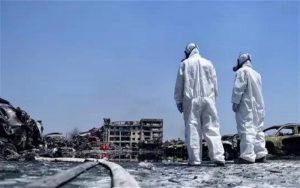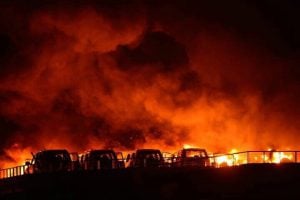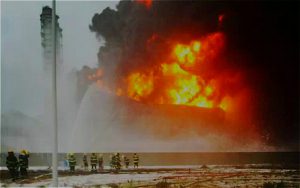The huge explosions at a chemical storage facility in Tianjin earlier this month was one of China’s most serious environmental disasters in recent times – and came against the backdrop of growing concerns among the Chinese public about the safety of chemical plants.
Late last week, another explosion, this time in Shandong province, further underlined the challenge of preventing accidents at facilities in China. The country is by far the biggest producer and consumer of chemicals where the need for new capacity often clashes with the wishes of an increasingly emboldened and environmentally-aware middle class.
2015 – August: Two huge blasts in the northeastern port city of Tianjin kill 114 people including 21 firefighters. Levels of sodium cyanide, a highly toxic chemical stored at the site, remain many times over the safe limit. Hundreds of angry residents have protested about lax oversight of the storage site and an apparent breach of rules on the distance between residential areas and chemical facilities. In the week after the blast, China’s anti-graft watchdog said it will investigate the chief of China’s State Administration of Work Safety.
2015 – April: An explosion ripped through the Gulei PX factory in Zhangzhou, Fujian province, leaving 15 injured, almost two years after a similar accident at the plant had prompted a local official to promise in 2013 that it would never happen again. Public unease about PX plants erupted into mass protests in Shanghai in late June.
2014 – August: A blast at a Taiwanese-owned car parts factory in Kunshan near Shanghai killed at least 75 and seriously injures 200 after a flame ignited metallic dust. The city’s work safety regulator said it had warned the factory of the potential for an explosion several times, but it was ignored.
2014 – April: A benzene leak into the Lanzhou section of the Yellow River – the only source of drinking water for the provincial capital – left residents without running water for two days. A subsidiary of China National Petroleum Corp (CNPC) has since agreed to pay the government of Lanzhou 100 million yuan (US$16 million) for incidents that polluted air and water in the city in the northwestern province of Gansu. The money will be used to upgrade the drainage system at the CNPC subsidiary to prevent any more leaks into the city’s soil and water table, and at the time was one of the largest fines paid in China for an industrial accident.
2013 – November: An explosion at a pipeline in Qingdao killed 55 people and leaked crude oil into Yellow Sea. An investigation led by the State Administration of Work Safety found poor pipeline layout and maintenance, and an insufficient emergency response, was mainly responsible for the accident. Sinopec apologised publicly and nine senior executives were fired.
2013 – June: A huge fire sparked by an ammonia leak in a poultry plant in Jilin province killed 113. The factory had no emergency exit while most escape routes were locked.
2011 – June: An oil spill polluted 5,500 square kilometres of northeastern China’s Bohai Bay, the worst marine environment disaster in China. The scale of the accident was covered up by the authorities for up to a month before Chinese press reports uncovered the scale of the damage. The joint operators of the oilfield, ConocoPhillips and China National Offshore Oil Co, were ordered to establish two funds to clean up and compensate for any damages arising from the incidents. Fishermen went to court to file a lawsuit for financial losses.
2010 – July: A spill of crude oil following an explosion near Dalian was at that time one of China’s worst oil-related environmental disasters. Official investigations found that the explosion was caused by improper injections of strongly oxidizing desulfurizer into the oil pipeline after an oil vessel had finished unloading its oil. PetroChina was sued US$32 million in one of nation’s largest public interest lawsuits five years later.
2005 – Nov: Supply of water to Harbin, one of northern China’s biggest cities, was cut off for almost a week after explosions at a chemical plant in Jilin polluted the Songhua river with around 100 tonnes of pollutants containing highly-poisonous benzene and nitrobenzene. Investigators concluded that the plant had had no effective contingency plans for such accidents and Jilin environment officials had failed to report the potential water pollution risks comprehensively and accurately.
The State Environmental Protection Administration (now the Ministry of Environmental Protection) minister Xie Zhenhua lost his job because of the spill, and was also blamed for initially underestimating the scale of the disaster. A vice mayor of Jilin city hanged himself that year after national media criticised city officials for deliberately covering up the spill, delaying preparations and causing panic in Harbin.




